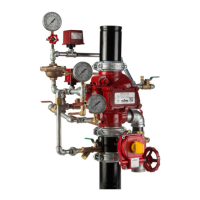MAR 2018 GFV-305 (Formerly H-3) Page 9 of 11
tion or re department. If such connections are
found, give proper notice to the signal receiving
station before proceeding with the test.
Note: A main drain test may also operate local re alarms unless they are tem-
porarily disabled.
DRY SYSTEM TRIP TEST
PROCEDURE
Proper operation of the RCW Valve (i.e., opening of the
RCW Valve as during a re condition) must be veried, as
described by the applicable Inspection Testing and Main-
tenance Standard (i.e. NFPA 25) or by the Local Authority
Having Jurisdiction. Globe Sprinkler Corporation recom-
mends performing a trip test annually. The steps to perform
a trip test are as follows:
STEP 1. If a partial ow trip test is necessary, perform
the following additional steps. If a normal ow
test is being performed continue to Step 2:
1. Close the main control valve.
2. Open the main drain valve.
3. Open the main control valve one turn beyond the position
at which water just begins to ow from the main drain valve.
4. Close the main drain valve.
Note: Be sure to close the main control valve quickly after the trip of the valve has
been veried.
STEP 2. Open the inspectors test valve at the end of the
system.
STEP 3. Verify that the RCW Valve has tripped, as indi-
cated by the ow of water into the system and
activation of the water ow alarm.
STEP 4. Close the system’s Main Control Valve.
STEP 5. Close the Diaphragm Chamber Supply Control
Valve.
STEP 6. Reset the RCW Dry Valve in accordance with
the Dry Valve Setting Procedure.
DRY SYSTEM WATERFLOW
ALARM TEST PROCEDURE
Testing of the system water ow alarms must be performed as
described by the applicable inspection testing and maintenance
standard (i.e. NFPA 25) or as described by the local AHJ. To
test the water ow alarm, open the alarm test valve, which will
allow a ow of water to the pressure alarm switch and/or water
motor alarm. Upon satisfactory completion of the test, close the
alarm test valve.
MAINTENANCE
Note:
• All valves should be carefully inspected, tested, and
maintained in accordance with NFPA 25 or other
applicable Standard.
• It is important to ensure a clean water supply free
of debris and solid particles such as sand, gravel,
or mud.
• If, during an inspection of a water control valve,
sediment or free particles of matter are noted,
a further examination of internal valve parts is
necessary.
• All deposits should be removed from all operating
parts and ports. Vent holes through intermediate
chamber should be thoroughly cleaned and ushed
with clean water.
• Where difculty in performance is experienced, the
manufacturer or its authorized representative shall
be contacted before any eld adjustment is to be
made.
Clapper Facing. The rubber clapper facing should be
checked for wear or damage to determine that it is free of
dirt and other foreign substances. If found to be worn or
damaged (e.g., foreign matter embedded in the surface),
the facing should be replaced. If it is dirty, it should be
cleaned. Compounds which could damage the rubber fac-
ing must never be used.
Seat Ring. The seat ring should be checked for nicks and
for stones, dirt or other foreign matter lodged in the grooves
or holes. It should be cleaned thoroughly. If the seat ring is
found to be damaged, valve should be replaced.
Alarm Line Check Valve. The ¾” check valve connected
to the intermediate chamber should be checked for clapper
and seat condition.
RCW Valve. Main Drain Valve and all controlling valves
which are normally closed when the deluge valve is in the
set position should be checked to be sure that they are fully
closed and not leaking.

